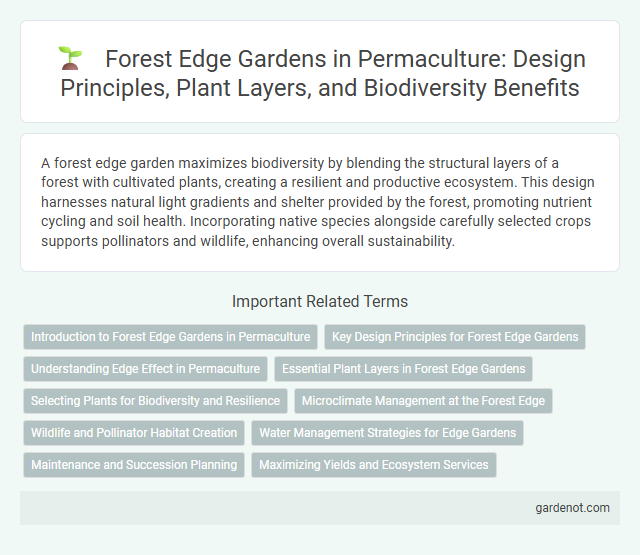A forest edge garden maximizes biodiversity by blending the structural layers of a forest with cultivated plants, creating a resilient and productive ecosystem. This design harnesses natural light gradients and shelter provided by the forest, promoting nutrient cycling and soil health. Incorporating native species alongside carefully selected crops supports pollinators and wildlife, enhancing overall sustainability.
Introduction to Forest Edge Gardens in Permaculture
Forest edge gardens in permaculture harness the transitional zones between forests and open land to maximize biodiversity and productivity. These gardens mimic natural ecosystems by integrating diverse layers of plants, including fruit trees, shrubs, herbs, and groundcovers, creating a self-sustaining environment. This strategic placement enhances microclimates, improves soil fertility, and supports beneficial wildlife, contributing to resilient and regenerative food systems.
Key Design Principles for Forest Edge Gardens
Forest edge gardens optimize biodiversity by integrating diverse plant layers that mimic natural forest ecotones, enhancing nutrient cycling and microclimate resilience. Key design principles include maximizing edge effects through strategic plant placement, selecting species with complementary functions such as nitrogen fixation and pest deterrence, and creating transitional zones that support pollinators and beneficial wildlife. Incorporating perennial plants and maintaining soil health through mulching and minimal disturbance fosters sustainable productivity and ecosystem stability in forest edge gardens.
Understanding Edge Effect in Permaculture
Forest edge gardens leverage the edge effect, where biodiversity and productivity are heightened at the boundary between forest and open land. This ecological transition zone maximizes sunlight exposure, microclimates, and species interactions, enhancing soil health and plant growth. Designing permaculture systems that mimic these natural edges promotes resilience and sustainable yield.
Essential Plant Layers in Forest Edge Gardens
Forest edge gardens integrate essential plant layers including canopy trees, understory shrubs, herbaceous plants, ground covers, and root crops to maximize biodiversity and yield. These layers create microclimates that improve soil health, promote water retention, and support beneficial wildlife. Efficient layering in forest edge gardens enhances nutrient cycling and resilient ecosystem functions critical to sustainable permaculture design.
Selecting Plants for Biodiversity and Resilience
Selecting plants for a forest edge garden emphasizes native species that support local wildlife, improve soil health, and enhance ecosystem stability. Incorporating a diverse range of trees, shrubs, herbs, and ground covers creates layered habitats that foster pollinators, beneficial insects, and wildlife corridors. Prioritizing drought-tolerant and pest-resistant varieties increases garden resilience and reduces maintenance needs in permaculture systems.
Microclimate Management at the Forest Edge
Forest edge gardens leverage natural microclimate variations by utilizing the transitional zone between woodland and open land to optimize plant growth. Strategically placed vegetation buffers reduce wind speed and moderate temperature fluctuations, creating favorable conditions for diverse crops and beneficial insects. This microclimate management enhances soil moisture retention and extends growing seasons, increasing overall garden productivity and resilience.
Wildlife and Pollinator Habitat Creation
Forest edge gardens enhance biodiversity by providing diverse food sources and shelter for wildlife and pollinators. Incorporating native flowering plants and shrubs attracts essential pollinators such as bees, butterflies, and hummingbirds, boosting ecosystem resilience. These gardens create critical habitats that support bird nesting, insect breeding, and small mammal foraging, promoting a balanced permaculture system.
Water Management Strategies for Edge Gardens
Forest edge gardens utilize strategic water management techniques like swales and berms to capture and retain rainwater, enhancing soil moisture and reducing erosion. Mulching with organic materials maintains humidity and promotes water infiltration, supporting diverse plant growth at the garden's periphery. Integrating drought-tolerant species alongside water-loving plants optimizes water use efficiency, creating a resilient and sustainable edge ecosystem.
Maintenance and Succession Planning
Forest edge gardens require regular maintenance such as pruning, mulching, and weed control to promote healthy plant growth and maximize productivity. Succession planning involves carefully selecting and spacing plants to ensure continuous harvest and natural regeneration, incorporating nitrogen-fixing species, pioneer shrubs, and fruit trees. Monitoring soil health and adjusting plant guilds helps sustain ecosystem stability and long-term yield in permaculture systems.
Maximizing Yields and Ecosystem Services
Forest edge gardens optimize space by integrating diverse plant layers, enhancing sunlight capture and nutrient cycling for maximal yields. Strategic plant selection supports pollinators and beneficial insects, boosting natural pest control and ecosystem resilience. This synergy between productivity and biodiversity strengthens soil health and water retention, promoting sustainable, multifunctional landscapes.
Forest edge garden Infographic

 gardenot.com
gardenot.com